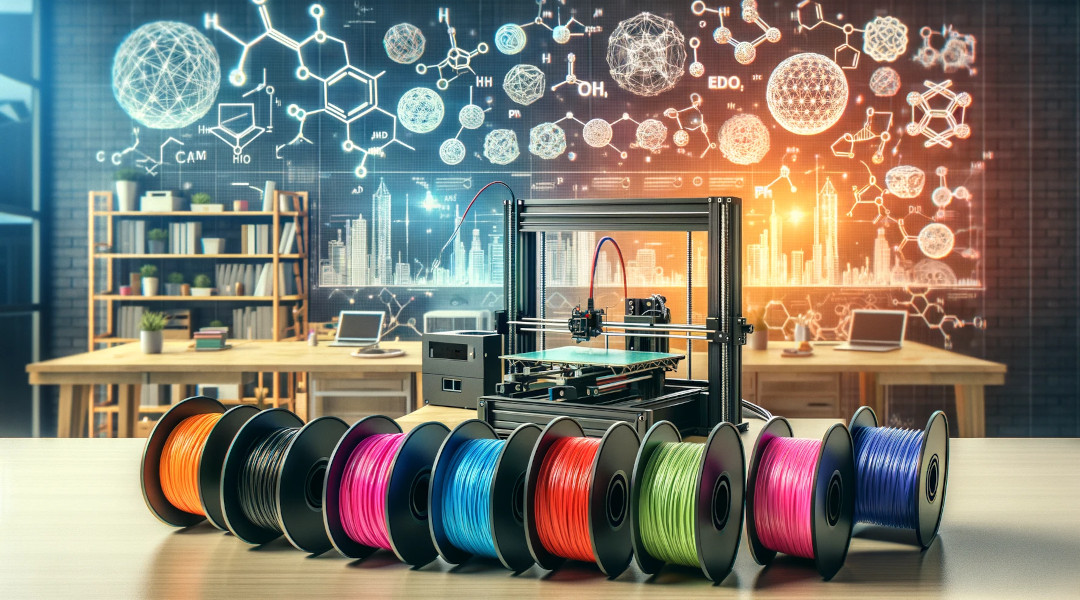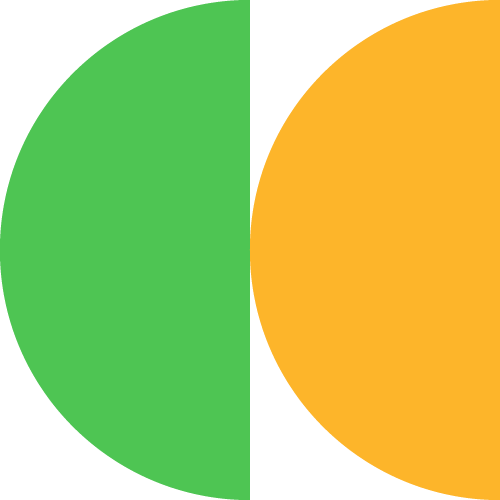W dynamicznym świecie druku 3D wybór materiału jest równie ważny, jak sam projekt modelu. Każde tworzywo termoplastyczne oferuje unikalny zestaw właściwości, które mogą poprawić lub zepsuć produkt końcowy. Poniżej przedstawiamy krótki przewodnik porównawczy dziesięciu najczęściej używanych tworzyw termoplastycznych do druku 3D. Oceniamy każdy z nich temperatury robocze, wytrzymałość, cenę i inne atrybuty, aby umożliwić wybór odpowiedniego dla Twoich potrzeb.
PLA (Polilaktyd)
PLA to biodegradowalny materiał pozyskiwany z materiałów odnawialnych, takich jak skrobia kukurydziana lub trzcina cukrowa, oferujący błyszczące wykończenie i łatwy w użyciu ze względu na stosunkowo niską temperaturę topnienia. Dodatkowo jest dostępny w różnych kolorach i efektach (świecący, metalowy, drewniany itp.). Jest również prawie bezwonny po wydrukowaniu.
Main Uses: Ideal for prototyping, educational purposes, art, and decorative items due to its simplicity and aesthetic appeal.
Pros: Simplistic in its printing process, PLA is a favorite among beginners. Its color range is vast, giving ample design flexibility.
Cons: Its limited heat resistance and durability make it less suitable for heavy-duty applications.
Temperature: PLA has a lower melting point around 180°C and can be printed on a cool or slightly heated bed.
Strength: Less durable than ABS, but sufficient for non-functional prototypes or decorative objects.
Price: Affordable; widely used due to its low cost.
ABS (Acrylonitrile Butadiene Styrene)
Known for its robustness, ABS offers a certain degree of flexibility combined with high-temperature resistance.
Main Uses: A top choice for functional parts in automotive components, toys (like LEGO), electronic housings, and various household items.
Pros: Functional parts thrive with ABS due to its ability to be sanded and painted. Additionally, acetone can be employed post-processing to refine the finish.
Cons: Tends to yellow over time. The material may emit fumes during the process and is susceptible to warping.
Temperature: ABS has a melting point of about 220°C and requires a heated bed at around 100°C to prevent warping. Price: Low. Comparable to PLA.
PETG (Polyethylene Terephthalate Glycol)
PETG offers a harmonious blend of strength and flexibility, marked by significant impact resistance. It’s food-safe, has low shrinkage, and offers good chemical resistance. It’s also more flexible than PLA and ABS.
Main Uses: From food containers to mechanical parts. It’s also common in medical braces and transparent components.
Pros: Melding the ease of PLA and the resilience of ABS, PETG offers water and chemical resistance and can even be transparent.
Cons: Its tendency to be stringy requires print adjustments, and its hygroscopic nature means it can absorb ambient moisture.
Temperature: Prints at around 245°C with a heated bed recommended at 60-80°C.
Strength: Combines the ease of printing seen in PLA with the strength and durability closer to ABS.
Price: Mid-range; slightly more expensive than PLA and ABS.
TPU (Thermoplastic Polyurethane)
TPU is a beacon of flexibility in the 3D printing world. It’s stretchy yet maintains an admirable degree of durability.
Main Uses: TPU is a frontrunner for creating flexible objects like phone cases, wearables, medical devices, and even some footwear components.
Pros: Its pliability is unmatched, coupled with commendable abrasion resistance and resilience against oils and greases.
Cons: Printing with TPU demands patience and slower speeds due to its supple nature.
Temperature: Typically prints at around 220-250°C.
Strength: Renowned for its flexibility, durability, and shock absorption.
Price: Higher than PLA and ABS but justified by its unique properties.
Nylon
Nylon’s strength and wear resistance are complemented by its flexibility, making it a diverse material choice.
Main Uses: Nylon is ideal for heavy-duty applications like gears, tools, hinges, drone components, and even some fashion items.
Pros: Nylon boasts chemical resistance and can be dyed post-printing to achieve a variety of aesthetic effects.
Cons: Its hygroscopic tendencies, meaning it absorbs moisture, making storage and handling crucial to maintain print quality.
Temperature: Requires higher temperatures around 250°C to 270°C, with a heated bed up to 70°C. A heated chamber and a good bed are often necessary for nylon printing.
Strength: High strength and durability, excellent wear resistance, and good impact resistance.
Price: Tends to be more expensive due to its performance characteristics.
PC (Polycarbonate)
PC is an incredibly strong material known for its impact resistance and optical clarity. Requires an enclosed printer to maintain high ambient temperature and reduce warping.
Main Uses: Suitable for bulletproof glass, eyewear lenses, and any application requiring high strength and transparency.
Pros: High thermal resistance and strength. Clear PC offers near-optical clarity.
Cons: Requires high printing temperatures usually in a chaber and a very good heated bed. It’s prone to warping and requires good bed adhesion.
Temperature: High printing temperatures between 260°C and 310°C with a heated bed at 110°C to 120°C.
Strength: Superior strength and toughness, high heat resistance, and good transparency.
Price: One of the more expensive options due to its superior properties.
ASA (Acrylonitrile Styrene Acrylate)
ASA is similar to ABS but has better UV, weather, and chemical resistance.
Main Uses: Perfect for outdoor applications like garden equipment, outdoor fixtures, or automotive exteriors.
Pros: Superior weather resistance, making it durable for outdoor use. Less prone to yellowing from UV exposure compared to ABS.
Cons: Like ABS, it can produce fumes during printing, so good ventilation is essential.
Temperature: Prints at around 240°C to 260°C, with a heated bed at around 80°C to 100°C.
Strength: Similar to ABS but with better UV and weather resistance.
Price: Comparable to ABS; a good choice for outdoor applications.
PEEK (Polyether Ether Ketone)
PEEK is a semicrystalline thermoplastic with excellent mechanical and chemical resistance properties that are retained to high temperatures.
Main Uses: used to fabricate items for demanding applications, including bearings, piston parts, pumps but also often used in medical implants and aerospace applications due to its bio-compatibility and strength-to-weight ratio.
Pros: the best strength-to-weight ratio.
Cons: require very high temperature and special 3D printers hence including also the cost of this material created productions are expensive.
Temperature: Requires high temperatures, around 360°C to 400°C, with a heated bed at 120°C to 160°C.
Strength: Exceptional mechanical and chemical resistance, high thermal stability.
Price: Among the most expensive thermoplastics due to its high-performance characteristics.
PP (Polypropylene)
PP is known for its fatigue resistance, elasticity, and toughness. It’s resistant to many chemicals and has a low friction surface.
Main Uses: Used for creating living hinges, flexible parts, and chemical-resistant containers.
Pros: It’s lightweight, resistant to chemicals, and has excellent fatigue resistance.
Cons: Can be challenging to print due to warping and bed adhesion issues.
Temperature: Prints at moderate temperatures around 220°C to 250°C.
Strength: Tough and flexible with good fatigue resistance.
Price: Reasonably priced; a practical option for living hinges or durable packaging.
HIPS (High Impact Polystyrene)
HIPS is a lightweight material similar to ABS but with added flexibility.
Main Uses: Often used as a dissolvable support material alongside ABS. It can also be used for creating lightweight prototypes or models.
Pros: It can be dissolved in d-limonene, making it useful for supports. It’s easy to paint and glue.
Cons: Requires a heated bed for printing and has similar warping issues as ABS.
Temperature: Similar to ABS, printing at around 220°C to 240°C with a heated bed.
Strength: Provides good impact strength and toughness.
Price: Inexpensive; often used as a support material because it’s soluble in limonene.
Notable Properties: Can be sanded and glued, making it versatile for multi-material prints.
Summary
Each thermoplastic material brings something unique to the table. While ABS and PLA are the go-to for cost efficiency and ease of use, materials like PEEK and PC offer advanced properties for demanding applications. Architects, manufacturers, and workshop technicians should consider the end-use of their 3D printed parts—whether it’s for a prototype, a functional component, or an aesthetic piece—when choosing a material. Balancing the interplay of temperature, strength, price, and specific properties will guide you to the perfect material choice for your 3D printing needs.
Sustainability is becoming increasingly important in material selection, especially in industries that are conscientious about their environmental impact. When it comes to 3D printing, sustainability can refer to the energy required to process materials, the source of the raw materials (biobased or petroleum-based), and the end-of-life options for the printed objects (recyclable, biodegradable, or non-biodegradable).
Below is a summarized table that includes basic sustainability notes for each material, alongside their temperature, strength, price, and other notable properties:
| Material | Printing Temp. (°C) | Strength | Price | Notable Properties | Sustainability |
|---|---|---|---|---|---|
| PLA | 180-210 (Bed: ~60) | Moderate | Low | Biodegradable, wide color range | Biodegradable; made from renewable resources |
| ABS | 220-240 (Bed: ~100) | High | Low | Durable, can be smoothed with acetone | Non-biodegradable; emits fumes; recyclable |
| PETG | 245 (Bed: 60-80) | Medium | Medium | Food-safe, chemical resistant | Recyclable; more sustainable than ABS |
| TPU | 220-250 (Bed: ~100) | High | High | Flexible, wear resistant | Non-biodegradable; recyclable in some facilities |
| Nylon | 250-270 (Bed: ~70) | Very High | High | Impact resistant, durable | Non-biodegradable; absorbs moisture |
| PC | 260-310 (Bed: 110-120) | Very High | High | Transparent, heat resistant | Non-biodegradable; recyclable |
| ASA | 240-260 (Bed: 80-100) | High | Medium | UV and weather resistant | More weatherable than ABS; recyclable |
| PEEK | 360-400 (Bed: 120-160) | Exceptional | Very High | Biocompatible, high thermal stability | High performance but expensive; recyclable |
| PP | 220-250 (Bed: ~100) | High | Medium | Chemical resistant, low friction | Recyclable; resistant to degradation |
| HIPS | 220-240 (Bed: ~100) | Moderate | Low | Soluble in limonene, can be glued/sanded | Non-biodegradable; often used as dissolvable support |



